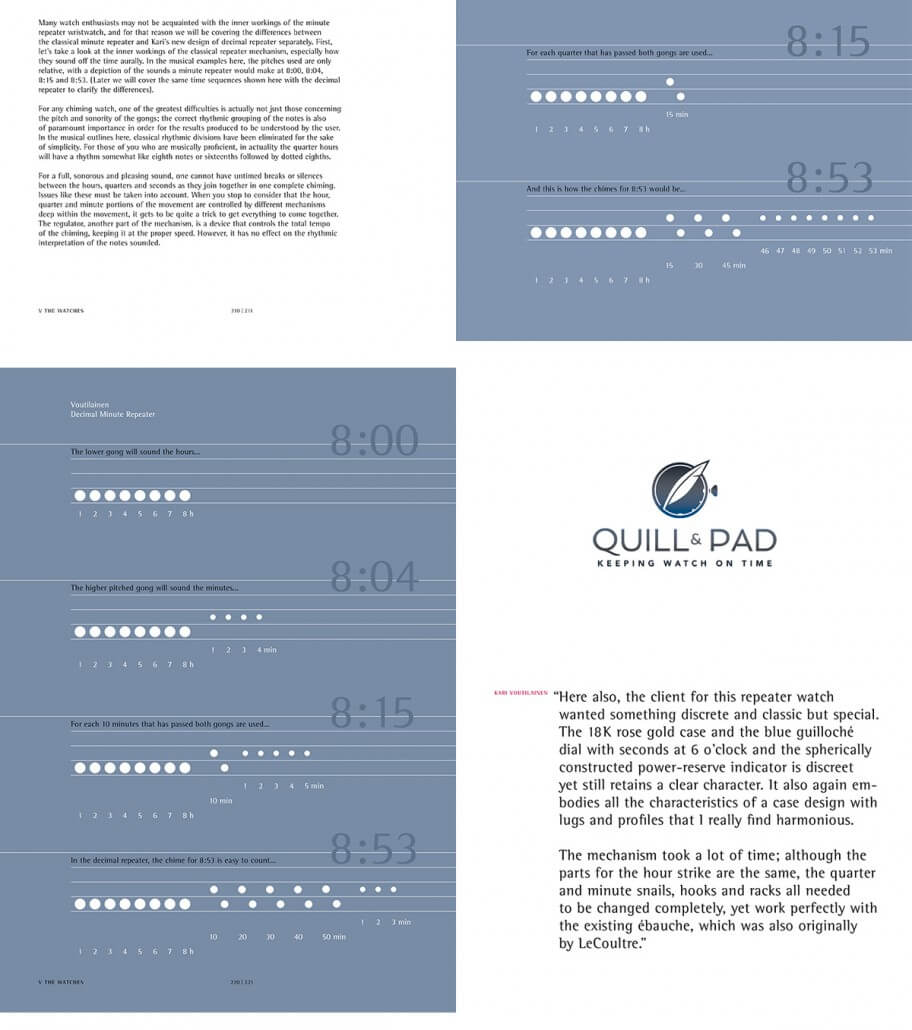“Työ puhuu puolestaan.”
This Finnish proverb means, “A man is valued by his work, not his words.”
And it most definitely characterizes the introverted, Finnish master watchmaker Kari Voutilainen to the proverbial tee. It is no wonder that this book published by the boutique publishing house called Editions Simonin founded and run by WOSTEP’s first director, Antoine Simonin, starts out with these wise words so full of meaning for its subject.
Written by a long-time observer of the independent watchmaker scene, Theodore Diehl, the book entitled Kari Voutilainen Horlogerie d’Art was released in time to celebrate the tenth anniversary of Voutilainen’s boutique brand and the thirtieth anniversary of his overall work as a watchmaker in 2014.
Kari Voutilainen Horlogerie d’Art is divided into seven chapters whose titles pretty much explain their content: “Prologue” (an introduction by Diehl), “The Watchmaker,” “The Passion,” “The Workshop,” “The Creation,” “The Watches,” and “Epilogue” (Diehl’s wrap-up).
The Content
“The Watchmaker” section traces Voutilianen’s life story, while “The Workshop” goes into the practical methods practiced within the elegant estate in Môtiers that is simultaneously watchmaker’s atelier, production workshop, and home to the Finnish watchmaker and his family.
“The Passion” is interesting because it tells the story of how Voutilainen decided to make watches with his own name on them and what it took to attract other good watchmakers to work with him.
“I couldn’t survive if I ever lost contact with the roots of my passion,” Voutilainen explains in the last sentence of that section. And I believe him.
“The Creation” goes more into the philosophy behind Voutilainen’s timepieces, which starts with his study of the eighteenth-century heroes making up the golden age of horology – watchmakers such as Ferdinand Berthoud, Thomas Earnshaw, John Harrison, and George Graham.
And in this section, Diehl writes a very astute and interesting thing, which is more relevant than ever regarding today’s horological scene.
“In the real world, there is no manufacture in Switzerland today that makes everything totally on their own, yet for clients unaware of the real economics and history of the industry, the term ‘manufacture’ still often impresses.”
“I will leave it up to the readers if this is good or bad; what is interesting is that today many high-end watch collectors will often knowledgably collect a particular variety of caliber and/or escapement type for their collections based upon private research into how and perhaps where they are manufacture, and it is this kind of engaged interest that supports and propels the industry to further develop a rich and varied tapestry of mechanical solutions of all kinds.”
This chapter also describes various finishing techniques that Voutilainen’s workshop masters. He is widely acknowledged as one of the finest at work today when it comes to quality of finishing.
“The Watches” takes a detailed look back at all of the timepieces signed by Voutilainen, starting with the tourbillon pocket watch that he completed in 1994.
Perhaps most interestingly, several pages cover the topic of repeaters in detailed manner, including Masterpiece 6, the decimal repeater that Voutilainen introduced in 2004.
Imagery
I am well acquainted with the visual style of this book as it has largely been created by the same graphic artists and photographer that were behind the visuals of one of my own books, Twelve Faces of Time.
Baumann + Baumann from Schwäbisch Gmünd, Germany designed this visual treat. Barbara and Gerd Baumann are about as good at designing books as it comes: the duo has won practically every design award there is to win, including the coveted Red Dot. Therefore, it stands to reason that this book would be nothing short of a gem when combined with the interesting and beautiful photographs by Ralf Baumgarten.
I partnered with Baumgarten on the conception of Twelve Faces of Time, which won an IF-Design Award in 2010. So I know very well how meticulously he works and what visual treasures are likely to emerge from his shoots. The photographs here are no exception; in a word, they are stunning.
Some of them were taken during our shoots for Twelve Faces of Time – no surprise there as Voutilainen was also one of the 12 watchmakers we featured in that book – but most of them were taken later as Voutilainen had meanwhile moved into his new workshop in Môtiers.
My only gripe with this beautiful tome – if I may voice it this way – would be the absence of copyediting. The story is captivating, and Diehl did a fantastic job giving it the personal slant of an insider thanks to his years-long friendship with Voutilainen.
The little bits and bobs of errant language that could have been made practically perfect by the careful sweep of a professional copyeditor stick out like a scratch on an otherwise beautifully finished Voutilainen component to my practiced, perfectionist eye, though.
All in all, an excellent book, though, filled with great information on one of the most epic watchmakers of our time. This is a must-have for any fan of independent watchmaking in general and Voutilainen’s brand of horology in particular.
“The key for me is being very, very exclusive, much the same as a painting or a work of art is unique,” Voutilainen is quoted as saying in the book – a tome that unequivocally proves why his work truly is art.
Kari Voutilainen Horlogerie d’Art would make the perfect gift for the horophile in your life and is available to order online at Editions Simonin, Watchprint, and Amazon.
Quick Facts
Author: Theodore Diehl
Photographer: Ralf Baumgarten with watch photography by Guy Lucas de Peslouan, Patrick Perriard, Martial Racine, and Olivier Ziegler
Publisher: Editions Simonin
Book style: hardcover
Year of publication: 2013
Number of pages: 272
ISBN: 978-2-9700731-4-7
Language: English
Price: $330 / €232 / 255 Swiss francs






























































Leave a Reply
Want to join the discussion?Feel free to contribute!